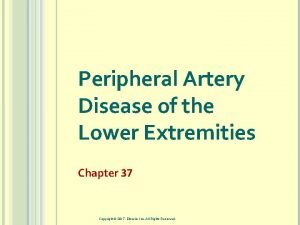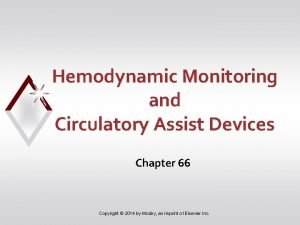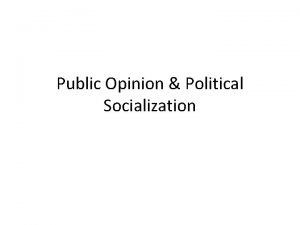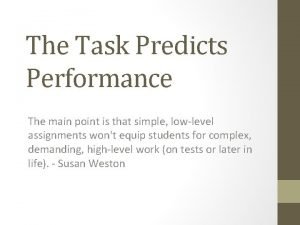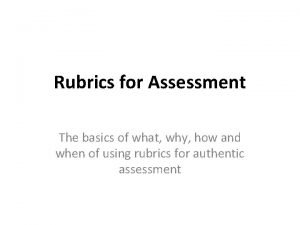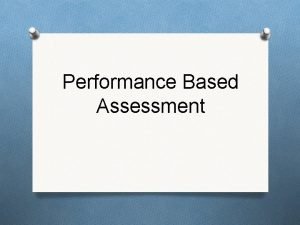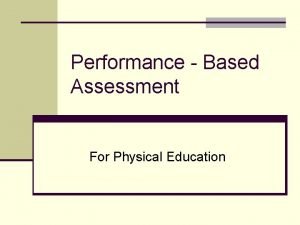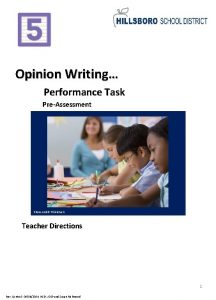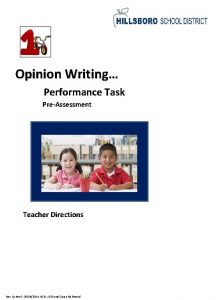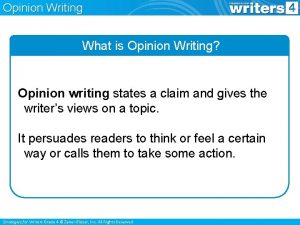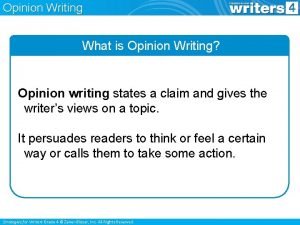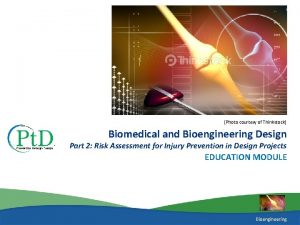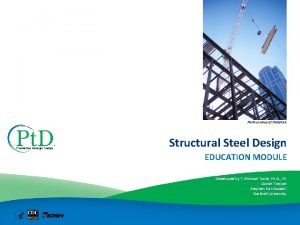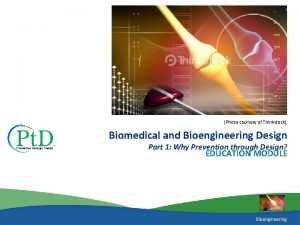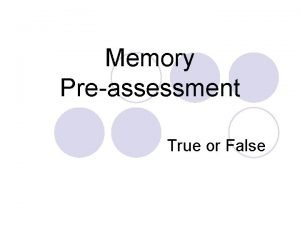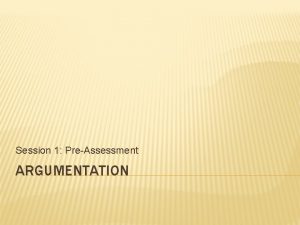Opinion Writing Performance Task PreAssessment Photo credit Thinkstock















- Slides: 15

Opinion Writing… Performance Task Pre-Assessment Photo credit: Thinkstock Teacher Directions Rev. Control: 09/06/2014 HSD – OSP and Susan Richmond

Background This is a pre-assessment to measure the task of writing and opinion essay. Full compositions or essays are always part of a Performance Task. A complete performance task would have: Part 1 • A Classroom Activity (30 Minutes) (35 minutes) • Passages to Read (2 – 4 depending on the grade) • 3 Research Questions Part 2 • A Full-Composition (70 Minutes) This assessment is an abbreviated Performance Task (PT). SBAC PT’s are normally completed in two days. The time-schedule below is the “norm, ” for a PT. Students should have access to spell-check resources but no grammar-check resources. Students can refer back to their passages, notes and 3 research questions as often they’d like. Directions 30 minutes 1. You may wish to have a 30 minute classroom activity. The purpose of a PT activity is to insure that all students are familiar with the concepts of the topic and know and understand key terms (vocabulary) that are at the upper end of their grade level (words they would not normally know or are unfamiliar to their background or culture). The classroom activity DOES NOT pre-teach any of the content that will be assessed! 35 minutes 2. Students read the passages independently. If you have students who can not read the passages you may read them to those students but please make note of the accommodation. Remind students to take notes as they read. During an actual SBAC assessment students are allowed to keep their notes as a reference. 3. Students answer the 3 research questions. During an actual SBAC assessment these questions would be scored. For this abbreviated PT they will not be. Students should also refer to their answers when writing their full opinion piece. 15 minute break 70 Minutes 4. Students write their full composition (opinion piece). SCORING An Opinion Rubric is provided. Students receive three scores: 1. Organization and Purpose 2. Evidence and Elaboration 3. Conventions 2 Rev. Control: 09/06/2014 HSD – OSP and Susan Richmond

Grades 3 -5: Generic 4 -Point Opinion Writing Rubric Statement of Purpose/Focus and Organization Score Statement of Purpose/Focus The response is fully sustained and consistently and purposefully focused: [Smarter Balanced CCSS ELA Writing Rubrics (Adapted)] Development: Language and Elaboration of Evidence Organization Elaboration of Evidence Conventions Language and Vocabulary The response has a clear and effective organizational structure creating unity and • opinion is clearly stated, completeness: 4 focused, and strongly maintained • opinion is communicated clearly within the context The response provides thorough and convincing support/evidence for the writer’s opinion that includes the effective use • effective, consistent use of sources, facts, and of a variety of transitional details: The response clearly The response and effectively demonstrates a expresses ideas, using strong command of precise language: conventions: • use of academic • few, if any, errors in usage and sentence and domainspecific vocabulary formation e • ffective and strategies • use of evidence from is clearly consistent use of • logical progression of sources is smoothly appropriate for the punctuation, ideas from beginning to integrated, comprehensive, audience and capitalization, and end and relevant purpose spelling • effective introduction and • effective use of a variety of conclusion for audience and purpose 3 The response is The response has an adequately sustained recognizable and generally focused: organizational structure, • opinion is clear and for though there may be the most part minor flaws and some maintained, though ideas may be loosely some loosely related connected: elaborative techniques The response provides The response adequate support/evidence adequately expresses demonstrates an for the writer’s opinion that ideas, employing a adequate command includes the use of sources, mix of precise with of conventions: • some errors in usage facts, and details: more general and sentence • some evidence from language: material may be • adequate use of present transitional strategies with • context provided for the • some variety claim is adequate • adequate progression of ideas from beginning to end • adequate introduction and conclusion sources is integrated, though citations may be general or imprecise adequate use of some elaborative techniques The response is The response has an somewhat sustained inconsistent with some extraneous organizational structure, material or a minor drift and flaws are evident: • inconsistent use of in focus: 2 • may be clearly focused on the opinion but is insufficiently sustained • uneven progression of ideas from beginning to • opinion on the issue end may be unclear and • conclusion and unfocused introduction, if present, are weak The response may be related to the purpose but may offer little or no focus: 1 The response provides uneven, cursory support/evidence for the writer’s opinion that includes partial or uneven transitional strategies with use of sources, facts, and little variety details: weakly integrated, and citations, if present, are uneven • weak or uneven use of elaborative techniques specific vocabulary is generally appropriate for the audience and • purpose The response expresses ideas unevenly, using simplistic language: • use of domain- specific vocabulary that may at times be inappropriate for the audience and purpose formation are present, but no systematic pattern of errors is displayed adequate use of punctuation, capitalization, and spelling The response expresses ideas unevenly, using simplistic language: • use of domain- specific vocabulary that may at times be inappropriate for the audience and purpose The response has little or The response provides The response no discernible minimal support/evidence expression of ideas is demonstrates a lack organizational structure: for the writer’s opinion that vague, lacks clarity, or of command of • few or no transitional includes little or no use of is confusing: conventions: strategies are evident sources, facts, and details: • uses limited language • errors are frequent • may be very brief • may have a major drift • frequent extraneous ideas • use of evidence from may intrude • opinion may be sources is minimal, absent, confusing or ambiguous 0 • evidence from sources is • use of domain- in error, or irrelevant or domain-specific vocabulary • may have little sense of audience and purpose and severe and meaning is often obscured A response gets no credit if it provides no evidence of the ability to [fill in with key language from the intended target]. Rev. Control: 09/06/2014 HSD – OSP and Susan Richmond

Opinion Writing Pre-Assessment Student and Class Scoring: Scoring Key: Total # Correct 1 = Emerging 0 -4 2 = 5 -7 3 Developing = Proficient 8 - 10 4 = Exemplary 11 - 12 School Year: 2014 -15 Grade: Teachers Name: School: Focus and Organization Student Name: Score 3 Elaboration Conventions Student ELP and Evidence Total Score 3 4 10 1. Daffy Duck and Friends 2. Micky Mouse 4 4 4 12 3. Minnie Mouse 4 4 3 11 4. Road Runner 4 4 0 8 0 0 0 0 0 0 0 0 4 Total Students To use the Excel Version of this Score sheet. http: //sresource. homestead. com/index. html Rev. Control: 09/06/2014 HSD – OSP and Susan Richmond % Proficient % Exemplary 25% 75% 25% 50% 50%

Listening & reading Productive modalities*: Ways in which students communicate to others Speaking (e. g. , speaking, writing, and & drawing). Instruction and Writing assessment of productive modalities focus on students’ communication of their own understanding or interpretation. Interactive modalities*: Collaborative use of receptive and productive modalities as “students engage in conversations, provide and obtain information, express feelings and emotions, and exchange opinions” (Phillips, 2008, p. 3). Standard 4 Productive (S & W) An ELL can… …construct gradeappropriate oral and written claims and support them with reasoning and evidence. Listening, speaking, reading, and writing 10 - make accurate use of standard English to communicate in grade-appropriate speech and writing Receptive modalities*: Ways in which students receive communications from others (e. g. , listening, reading, viewing). Instruction and assessment of receptive modalities focus on students’ communication of their understanding of the meaning of communications from others. 9 - create clear and coherent grade-appropriate speech and text ELP 2 nd – 3 rd Grade Band Standards Organized by Modality 1 construct meaning from oral presentations and literary and informational text through grade-appropriate listening, reading, and viewing 8 determine the meaning of words and phrases in oral presentations and literary and informational text 3 speak and write about grade-appropriate complex literary and informational texts and topics 4 construct grade-appropriate oral and written claims and support them with reasoning and evidence 7 adapt language choices to purpose, task, and audience when speaking and writing 2 participate in grade-appropriate oral and written exchanges of information, ideas, and analyses, responding to peer, audience, or reader comments and questions 5 conduct research and evaluate and communicate findings to answer questions or solve problems 6 analyze and critique the arguments of others orally and in writing By the end of an English language proficiency level, an ELL in 2 nd – 3 rd Grade can. . . 1 2 …express an opinion about opinion a familiar topic. about a familiar topic or story. 3 …express an opinion about a familiar topic or story, giving one or more reasons for the opinion. 4 …express opinions about a variety of topics, introducing the topic & giving several reasons for the opinion. 5 …express opinions about a variety of topics, introducing the topic, giving several reasons for the opinion, & providing a concluding statement. This performance task is based on writing. As an option if you’d like to monitor growth for ELP as a second goal, teachers can choose to assess ELP standard 4 because it aligns with this specific performance task. Your student’s full composition can be analyzed to identify English language proficiency levels. It is evident that students will be navigating through the modalities to get to the end product. However, it is important to keep in mind what the full opinion writing performance task is assessing and how deeply the student understands class content and language. The ELP growth goal is to provide the “just-right scaffolds” for students to demonstrate their understanding in order for them to move from one proficiency level to the next. Rev. Control: 09/06/2014 HSD – OSP and Susan Richmond Oregon ELP Standards Aligned with Performance Task, 2014; Arcema Tovar

Opinion Writing… Performance Task Pre-Assessment Student Name: ___________ Date: _________ Rev. Control: 09/06/2014 HSD – OSP and Susan Richmond

Directions: 35 Minutes 1. Read each article. 2. Take notes as you read. You can use your notes to help you write your opinion essay. 3. Answer the 3 questions when you are done reading. You may also use your answers to help you write your opinion essay. STOP AND WAIT FOR YOUR TEACHER 70 Minutes 4. Write your opinion essay. Your Assignment: TV Time Opinion Performance Task The mayor of your town recently said: “It always seems really sad to see young people spending so much time staring at a television. If we could unplug all the TV sets in America, our children would grow up to be healthier, better educated, and more independent human beings. ” Your town’s newspaper, the Hillsboro Reporter, wants to print the four best student responses to the mayor’s statement. You will write an opinion paper telling whether or not you agree with the mayor. Do you think kids should watch television? Why or why not? You will write a newspaper article using information you have read. 7 Rev. Control: 09/06/2014 HSD – OSP and Susan Richmond

Source #1: Turn It Off! Grade Equivalent Lexile Measure Mean Sentence Length Mean Log Word Frequency Word Count TV-Turnoff Week On April 22 nd, many people will turn off their TVs. Instead of watching TV, people will go outdoors to ride bikes or to play. Will you join in – or will you just sit there and watch? For one week it will be TV Turnoff Week. A group called the TV Turnoff Network, started this event in 1995. This year, people from every state will join in the fun. Too Much TV When awake, kids spend more time watching TV than playing. School aged children watch about 28 hours a week of TV. Many doctors are worried. Studies show that watching too much TV can mean bad news. Kids may start bad eating habits by watching the many ads on TV about junk food. To stay healthy we need to play and exercise. That is hard to do when you watch TV. Children who watch more than 4 hours of TV each day may become overweight. TV is also full of violent shows, which may lead kids to act badly. Scientists did a new study about TV viewing. They found that kids who watched more than one hour of TV a day were more likely to show mean behavior as they grew older. Watching a lot of TV can affect how you do in school. When you are in front of the TV, you are not doing things like reading and getting your homework done. If you want to do better in school, turn off the TV! TV-Turnoff week is all about getting away from the TV. The network is not against TV but when your turn off the TV you tune into real life. Can you live without your favorite TV shows? One 8 year old boy, took part in TV-Turnoff last year. He said that, “there were 8, 000 other things” to do. Think of how busy you’d be if you tried just 80 of those things. Rev. Control: 09/06/2014 HSD – OSP and Susan Richmond 3. 9 790 12. 27 3. 62 319

Source #2: TV Can Be Good for Kids! Grade Equivalent Lexile Measure Mean Sentence Length Mean Log Word Frequency Word Count TV Can Be Good for Kids! Lots of kids love to watch TV. In fact, they like TV so much that they might hear something like this from mom or dad: “Enough! Turn that thing off and find something else to do!” It can be great advice if you are watching hours and hours of TV each day, but there are many reasons why some TV time can be good for kids. Brain Boost Is there a subject you really enjoy? More likely than not, there is a TV show, movie, or DVD that will help you learn more about that subject. Many kids watch and love nature shows, like those on Animal Planet. Maybe you saw a show about sharks, and now you are all ready to go to the library to check out more books about sharks. Are you into cooking? There are many cooking shows you might like. Even little kids can get help learning the alphabet on TV. Watching TV can help kids learn about a lot of subjects and want to make you learn even more. See the World Most kids are not able to go to a real jungle or see a tiger in the wild. But, we can see these things on TV. There are shows that let us see and learn about animals and people in faraway places. We now have the chance to see the world and learn about all kinds of people. Kids can learn and gain a better understanding of the world. Getting into Books Many movies on TV are based on books. Watching TV can encourage kids to read more. How? Parents can challenge their kids to read a book with the promise of watching the movie when they finish it. Or, kids may see a movie and like it so much that they decide to read the book. After reading the book and watching the movie, kids can discuss how the book and the movie are the same or different. This can help kids develop thinking skills. Good Role Models Many TV shows have started giving kids good role models. Some main characters are eating right, take care of the environment and treat others with kindness. As kids see their favorite characters making good choices, they will want to make good choices too. Parents and kids can talk about characters that didn’t make good choices and what would have been a better choice. It’s true that too much of anything is too much. But watching some TV can do a lot of good for today’s kids! Information is based on the following source: http: //kidstvmovies. about. com/od/healthytvhabits/a/tvgoodforkids. htm Rev. Control: 09/06/2014 HSD – OSP and Susan Richmond 4. 4 830 13. 72 439

Think About It. Then, answer each question. Interpret and Integrate Information Research Target 2 1. What is the one most important reason not to watch TV? What is the one most important reason to watch TV? Choose details from both articles. Evaluate Information Sources Research Target 3 2. “If we could unplug all the TV sets in America, our children would grow up to be healthier, better educated, and more independent human beings. ” Explain what this statement means. Use details from the texts to support your answer. Use Evidence Research Target 4 3. What information could you use to prove that we do not need to unplug all the TV sets in America and can still grow up healthy? Use details from the texts to support your answer. 10 Rev. Control: 09/06/2014 HSD – OSP and Susan Richmond

STOP Close your books and wait for instructions! 11 Rev. Control: 09/06/2014 HSD – OSP and Susan Richmond

Your Performance Task Your assignment: The mayor of your town recently said: “It always seems really sad to see young people spending so much time staring at a television. If we could unplug all the TV sets in America, our children would grow up to be healthier, better educated, and more independent human beings. ” Your town’s newspaper, the Hillsboro Reporter, wants to print the four best student responses to the mayor’s statement. You will write an opinion paper telling whether or not you agree with the mayor. Do you think kids should watch television? Why or why not? Now, write your newspaper article telling whether or not you agree with the mayor. Explain why you do or do not agree. Use reasons for your opinion and support your reasons with details from the sources using your own words. You may use your notes, your 3 answered questions and refer to the passages as much as you’d like. REMEMBER: A well-written opinion article: • • has a clear opinion is well-organized and stays on the topic has an introduction and a conclusion uses transitions uses details from the sources to support your opinion develops ideas clearly uses clear language follows rules of writing (spelling, punctuation, and grammar) You will receive three scores for your essay: 1. Organization and Purpose ü Statement of purpose/focus – how well you clearly state your opinions on the topic and maintain your focus ü Organization – how well your ideas logically flow from the introduction to conclusion using effective transitions and how well you stay on topic throughout the essay. 2. Evidence and Elaboration ü Elaboration of evidence – how well you provide evidence from sources about your opinions and elaborate with specific information ü Language and Vocabulary – how well you effectively express ideas using precise language that is appropriate for your audience and purpose 3. Conventions ü Conventions – how well you follow the rules of usage, punctuation, capitalization, and spelling Now begin work on your opinion article. Manage your time carefully so that you can 1. plan your article 2. write your article 3. revise and edit the final draft of your article Word-processing tools and spell check are available to you. 12 Rev. Control: 09/06/2014 HSD – OSP and Susan Richmond

Name 13 Rev. Control: 09/06/2014 HSD – OSP and Susan Richmond

14 Rev. Control: 09/06/2014 HSD – OSP and Susan Richmond

15 Rev. Control: 09/06/2014 HSD – OSP and Susan Richmond
 Thinkstock
Thinkstock Thinkstock
Thinkstock Ugc 10214
Ugc 10214 Photo credit
Photo credit Photo credit
Photo credit Private opinion becomes public opinion when
Private opinion becomes public opinion when This can be avoided by giving credit where credit is due.
This can be avoided by giving credit where credit is due. Tiered task bias task
Tiered task bias task Performance tasks definition
Performance tasks definition Task predicts performance
Task predicts performance The james lange theory of emotion states that
The james lange theory of emotion states that Holistic rubric
Holistic rubric Product-oriented performance-based assessment example
Product-oriented performance-based assessment example Types of performance based assessment
Types of performance based assessment Types of performance-based assessment
Types of performance-based assessment Rubric for performance task
Rubric for performance task
